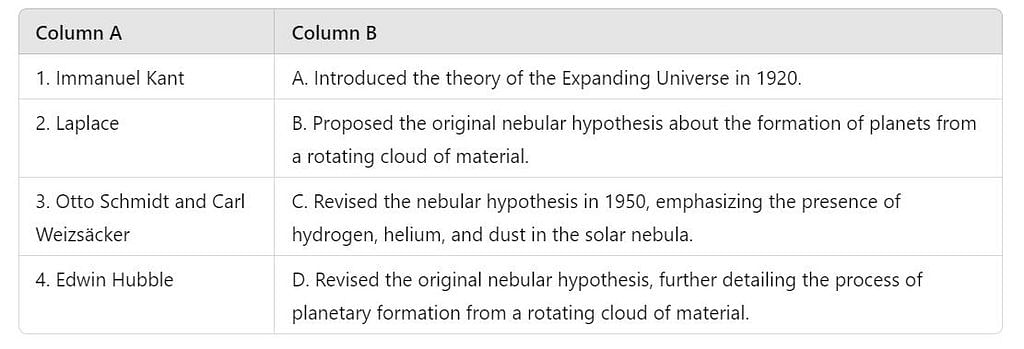Test: The Origin And Evolution Of The Earth - UPSC MCQ
10 Questions MCQ Test - Test: The Origin And Evolution Of The Earth
Which of the following statements accurately describes the origin and evolution of life on Earth based on the provided text?
Assertion (A): The Nebular Hypothesis suggests that planets formed from a rotating cloud of gas and dust around a young sun.
Reason (R): The process of accretion involved particles colliding and sticking together to form larger bodies.
| 1 Crore+ students have signed up on EduRev. Have you? Download the App |
Arrange the following events in the correct sequence as they occurred during the early formation of the Earth, evolution of lithosphere:
1. The Earth cooled and solidified into a smaller size.
2. Heavier materials like iron sank towards the center, causing lighter materials to rise.
3. Through the process of differentiation, the Earth-forming materials separated into different layers. These layers, from the surface to the center, include the crust, mantle, outer core, and inner core.
4. Materials inside the Earth began to separate based on their densities due to increasing temperature.
1. The Earth cooled and solidified into a smaller size.
2. Heavier materials like iron sank towards the center, causing lighter materials to rise.
3. Through the process of differentiation, the Earth-forming materials separated into different layers. These layers, from the surface to the center, include the crust, mantle, outer core, and inner core.
4. Materials inside the Earth began to separate based on their densities due to increasing temperature.
Assertion (A): The formation of the Earth's layers occurred due to the process of differentiation based on material density.
Reason (R): The early Earth was primarily composed of solid rock with no significant internal heating.
Which one of the following is not related to the formation or modification of the present atmosphere?
Match the following scientists and philosophers with their correct contributions to the theories regarding the origin and expansion of the universe:

Assertion (A): The Big Bang Theory posits that the universe is currently expanding from a singular point of infinite density.
Reason (R): This theory was first introduced by Edwin Hubble in the 1920s, providing evidence for a static universe.
Which of the following statements regarding the evolution of the Earth's atmosphere and oceans is/are correct?
i. The early atmosphere was primarily composed of hydrogen and helium, which were largely stripped away by solar winds.
ii. Photosynthesis by early life forms significantly decreased the levels of oxygen in the atmosphere.
iii. Continuous volcanic eruptions contributed to the addition of gases and water vapor to the atmosphere.
iv. The Earth's oceans formed within 500 million years of its formation, primarily through the condensation of water vapor.
Arrange the following stages in the correct order of planet formation as described:
1: Condensation forms small-rounded objects around the core.
2: Gravitational forces create a core in the gas cloud.
3: Numerous small planetesimals accrete to form fewer, larger planetary bodies.
4: A rotating disc of gas and dust develops around this core.
Given below are two statements:
Statement I: The Big Bang Theory posits that all matter and energy originated from a singularity.
Statement II: Galaxies began to form due to uniform distribution of matter and energy in the early universe.
In the light of the above statements, choose the correct answer from the options given below:

















